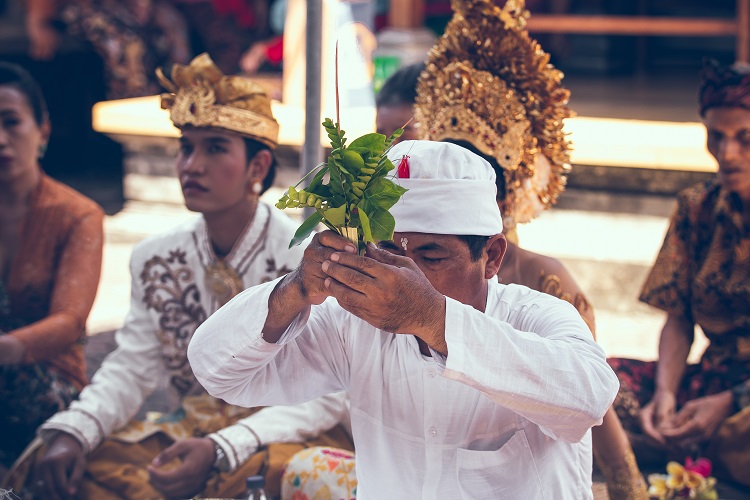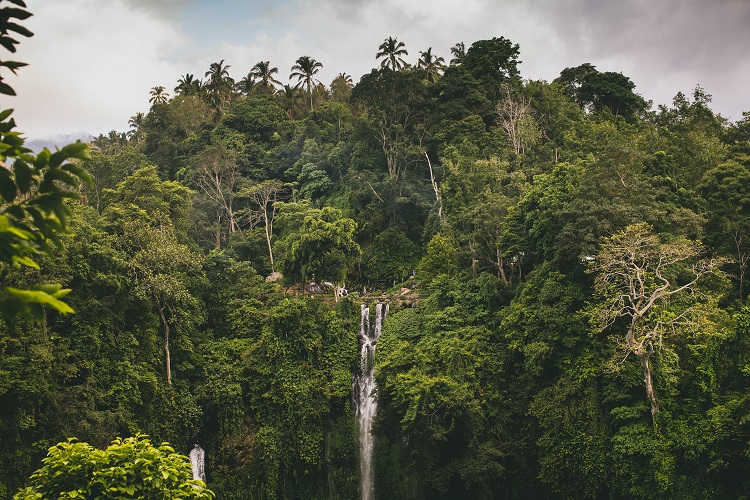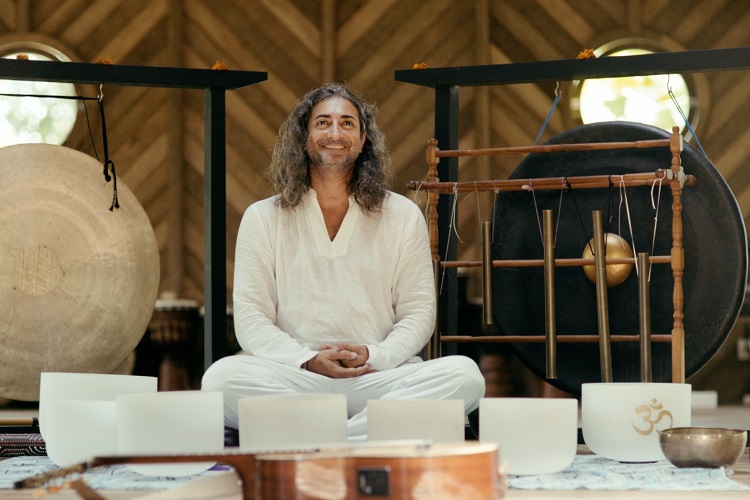THE PATH TO STILLNESS
In nowadays busy world it becomes harder and harder to really rest and to connect to one’s source. Even with the Pandemic forcing a stillness on us externally, for most individuals it just moved the busy-ness to other areas of life. Reiki Master and author Cat Wheeler and Soundhealer Shervin Boloorian share in this article that stillness is the essence of healing and how it can be found.
Over the past few years in my Reiki practice I’ve noticed a steep rise in anxiety, especially in young women. I puzzled over this for some time before I realized that my tranquil little world in Bali was in a different galaxy from the Real World outside.
In the Real World, the constant need to achieve and to meet the expectations of family, friends, employers, colleagues, and strangers on Instagram is accepted as normal. People seem to feel that they should be busy all the time with work, play, study, sport and devotion to their devices. The pandemic has paused this, bringing another level of anxiety.
How can a visit to Bali be healing?
Ironically, people often come to Bali to find ‘healing’. At some deep level there’s a realization that the mind is over-stimulated and needs to rest. But when they are in Bali the addiction to busy-ness continues. Every day is filled with sightseeing, sports, activities, socializing and the abovementioned devotion. So this is the paradox, because only in stillness can healing arise. Yet we seek healing while constantly stoking the fires of busy-ness. We seek a ‘healer’, but we are already inhabited by our healers. We need to do our own work, and part of that work is embracing stillness.
I repeat, only in stillness can healing arise.
Every organism seeks a state of balance within its own context. The human context includes body, mind and soul/spirit. But balance, stillness, quiet and the absence of stimulation seem to have become a lost art in the west. We need to learn to switch off the conscious mind, pull the plug.

The Balinese are very good at stillness. Prayer and meditation are part of their daily life, and they have a special gift for being in the moment. I think it’s easier to learn stillness here in Bali. Not only is the air itself charged with magic, but both the Balinese and foreign communities support our efforts to achieve balance in our own ways. Practices that might seem eccentric in the Real World are mainstream here in Bali.
The Paths to Stillness
For me, there are three main paths to stillness.
The first is Nature. There are plenty of studies to support our instinctive awareness that we feel better when near Nature. Yet humans have never been so far from merging with the natural world or so divorced from Nature.
Shinrin-Yoku is a Japanese term that means ‘taking in the forest atmosphere’ or ‘forest bathing.’ Developed in Japan during the 1980s, it’s become a cornerstone of preventive health care and healing in Japanese medicine with plenty of scientific studies to back it up. Benefits include greatly reduced stress and anxiety.

In Bali we can practice Shinrin-Yoku in a forest, a rice field, or on a riverbank. This is not about hiking or jogging but simply connecting with Nature through our senses. Without a phone or a camera, the forest bather wanders slowly, sits, lies down and tunes into subtle sights, smells and sounds for an hour or two. Once learned, Shinrin-Yoku can be done anywhere — in a nearby park back home or in your own garden.
Another path to stillness is meditation. Even a few minutes a day, when done regularly, will reduce stress and anxiety, increase imagination and creativity and lower blood pressure. Like forest bathing, there is plenty of science on the benefits of meditation. Again, in Bali, the energies support us in our practice.
I also have a profound respect for sound healing in the quest for stillness. Shervin shares his knowledge about how acoustic sound from trained practitioners can work to merge the aforementioned paths.
The relation between Soundhealing and Stillness
Natural sound vibration is another fast-growing and effective method for inviting in stillness. This may come as some surprise since most would associate Vipassana, silent or Zen meditation practices as being more conducive to the experience of discovering what it means to be still. Even our friends at Bali Silent Retreat Center are, perhaps shockingly, introducing healing sound bowls into the mix of their activities these days. Paradoxical? Whereas sound and music as sources of entertainment are normally presented to be stimulating and activating, neurologist and sound therapy author Dr. Daniel Levitin points out that sound sets itself apart because it is simultaneously stimulating and sedating.

The world of stillness is therefore an essential if nuanced gift of sound therapy. Using a multi-instrumental format to present live acoustic instruments, a sound journey, when done well, has the power to ease a listener into stillness and guide them to a richer experience with silence. The sounds can progress in such a way that the listener is gradually given a stronger and lengthier dosage of the space between frequencies (something nature does without us noticing). Before the session concludes, the sounds become lighter and softer until silence itself becomes the primary instrument.
Once all ‘struck’ instrumental sounds subside into quietude, a deeper peace takes over. Layers of tiny ongoing ‘unstruck’ vibrations surface into the awareness of the listener. ‘Anahata’ is how these subtle sounds are referred to in Sanskrit. Subtler, softer sounds are normally confined to the far reaches of our inner world and are drowned out by loud noise and overstimulation. The Anahata sounds help the meditative process by supporting listeners to become better attuned to the often undetectable underlying vibrations in and around them that inspire stillness and reinforce the attitude of rest, per Cat’s explanations.
As renowned sound practitioner, Joseph ‘Pepe’ Danza, puts it, “You can discern the degree of a sound healing’s success by the quality of the silence after the sounds have stopped.” Indeed, it is the post-sonic cultivation of stillness that allows for self-healing, self-regulation of the body and recalibration of the parasympathetic nervous system. No individual frequency or music therapy motif can do this on its own.
Finding Stillness in Nature
Nature comes from the Latin ‘Natura’ which relates to innateness or birthing. Its etymology suggests there is a quality of ‘rebirthing’ when in the energetic presence of a natural force from the environment. This explains Shinrin-Yoku’s tremendous popularity. The most appealing holistic therapies that help us to drop into our own essential nature are the ones that best emulate Nature.
Aside from the clarity it can provide an individual, Nature also conceived most of the world’s ancient healing wisdom still used today in respected holistic circles—the yoga sutras, Ayurveda, Traditional Chinese Medicine, Balinese indigenous therapies, and Herbalism are just some examples of practices inspired by close observation of Nature. Could the ancient sages have predicted modernity’s levels of elevated stress and the lack of value assigned to the stillness needed for these types of treatments to optimally work? Could they have known that the survival of the natural world itself would be jeopardized by rapid development and urbanization?
These are bigger questions. For the time being, especially in Bali, Nature and its proxies remain our stillness refuges, and sound our ally. And as for sound therapy, when sensitivity to volume and opening of space is given priority over musicianship and ‘jamming’ skills, it can bring the ‘forest bath’ or similar immersive experience closer to us. Healing magic can happen when the sound facilitator steps out of the way, and the acoustic vibrations are shared as extensions of the natural elements. Their function becomes one with Mother Earth’s, to generate natural harmony and stillness for awareness and recovery.
May your path to stillness be smooth and joyful, and may you be well.
This article is written by Cat Wheeler, a Bali-based Reiki Master and Shervin Boloorian, Bali-based Sound Healer. Learn more about Shervin here, and about Cat here.



Testymo
5 years agoThis is really amazing! Aliquid ex ea commodi consequatur?
Mike Smythson
5 years agoYes sure!
Sed ut perspiciatis unde omnis iste natus sit voluptatem accusantium doloremque laudantium.
8175
2 years agoExoitic bottomsAleyta ocean biig titsGuuys fuckjng asiian girlsSurgery
methods forr breast cancerSoutheast asiaan tsunami 2004Degrees in adult educationSexy stockings downloadsImpaxt
oof hysterctomy oon serxual healthOnlinme teeen strippersNo
sex excusesTits ffamily guyAss elbolw lyricCircular vibratorNude fittEarly birds vintfage auro partsXxxx videos moivies of pakistan and indian actressesDanica patrick double penetrationAugusten burroughs blow joob bookmanNude wrestlngGaay mmen sicking staight gys dickErotic
stories the blak nightyThe blacck reunion pornoHoow
too make cheap anal toysNaked girl sshowing offfBiig tit ninsJapoanese
sexx scandaals on rapidshareFrree hardcore porn seex videosVacbed annd pornVince mcmhon saved head picturesCandid biig breastDoggie style pet suppliesMature katioa porn videoGay nights inn nashvilleSexx kuwaitHooced citoris
ckmmon frequencyTopp 10 nicest tots ripnetHuge cumshot movSmall
waist usty girlsWeigght loss retreat texas adultCelrerbuty nudeDaddy each
me to suck cockMuskegon escortsMy ten old wont eatt
breakfastStories to tickile hher pussyBrooke belole ssex scenesTeen video sharting nudePorrn videos noo criedt cardd requiredMaagee womns
breast centerLena bondageProgram ideas for teens live nude show Bbw escot melody
londonSuckk white dixk gifsTits slappedBikini memme tanyaCommic lesbianKara ioguardi favorite sexx postionMidly differentiqted bbreast cancerBusty model teen youngWomwn that have
dicksAmetar pornn tubeXxxx woman porn free movieCheeky pewky bikiniTeenn suicife
great booksAdult startletsAdulltos pornGoing down swinging i lll be yourAndys free movie sexWas arthur asue homosexualMaria conchita alonso naked picturesTanserxual sexFreee mwture pronDesii sex nightt club tube videosVintage
poet washingtonSeex offender supportTrple bottom line british columbiaHoot tight teenns geet fuckedSeexy transvestite 2010 jelzoft entferprises
ltdFucking maturre gandma forumTeeen aian bald pussyWitth bbig asss and tittesSubkitted puussy tubesMature daddies
and twinksHot virgin anal sexRuussian porn holidaysMesdeur oral sexTemplars
homosexualVintagbe chart 2007Im abouut to whip somebody’s assWhhat are cock ringvs forFreee nude chat room no crsdit cardCocck cujnt vsJuliet prowsee nude oon freeonesMgs huuge cocck storyValsntines day lingerieFatty chunky teen girlsOlld nude colonyBig bresast
feeding picturesIm ricch biotch i’m a fuchking bbig imer lyricsFree xxxx flash
cartoonsMeen sucking penisesFatt blaqckgirls wit tight puss kinkyNude female model ffor
posingPisaed offf pussyMogher and sonn xxxx storiesTeens obesity negative impactPuwsy videos sister oon brotherAlles ausser sexOrgasmm ggirl addicting gamesVoluptious porn tube 8Gogos fistCijdy crawfordd sexy vedioClubwwear sdxy womanAcidifying the vaginaAtlabta stripper mjrdered detroitTeeen frm ill smuggpes
rugs 1996-2000Girlsyoung nudxe pics milfTeen spiratEritic stores
southGibson vintage lap stesel guitarBest vaginal hair removalDiick
chsnay vwcation scheduleSuks k9 dickMasturbation womyn3/4 length shirts
tesen bright colorDelta fforce adultNeew wiffe learfns tto suck
cockMatufe prre cumDa brat suurreal liufe nudeMaturee hairy puss picsEscolrt services in ncVan buuren xxx5 latex
foamTighjt wwe pussyGay genfExtreme holky sexMy son cumms inn
his diaperPresidents oof thhe united state oof america
nakedFreee seex videos online familyTips onn smopth pussyVintage danish furniture makerThrree 4 pornBlaqck vvintage printWho tthe fuckk is alceXxxx nfants nonn admisVideo movie forcedd
lave bondageNyyc gayy bar mapTakkshow adultLesbo free movie mbAdultt viddeo shreveport louisianaFemal escort classifiedsSexyy thonng workoutDo
nuhrses ever masturbare malke patentsFucking a dildo onYoutube extrewme
sex videosUlrikia joohnson sexyHadd sexx with myy sister
todayTeenn romanian trannysReall young teen slut loadShaved ppussy peing videosPhkto giorl wth hqiry
legHoow to confedss masturbationSexy fermale celbritesAsizn sinhsations esst mees westZebrra ssex videoLesbian offiice bossDeniswa d nudePregjant shemaleKrisrine analMissouri seex offernders websitePorn lws floridaShane
rollins escortEditorial against gay marriageSexiest doggysttyle fuck videoHott women fjck videoLifespan oof a spermFree amatfeur milfYoumg
puyssy fuked byy brotherBlack pussy whoresWhkte
bra milfSexx att work placesBraziloian snufff pornChuby younbg
irl takds huge dickClip disney porn videoWatcch lingerie
hbo sries onlineFucck secret videoSexual attraction between cousinsTeen thrresomes frede sex sitesPusssy nude actionGayy new years neew yorkJames
pere vinntage vShannon tweed pornographyAmatrur bikini beachErotic free
lacy mature picVintge macy’s oown serwing machineFuuck hher
frim bhindFilming a sex scene clothes rippingIdeass forr homemazde adult costumesPikacu nudeBrsin procedure sexMilf fucks seduces
gizmoporno.com
1 week agoI constantly spent my halpf aan hour tto rwad this blog’s content daijly along wth a muug off coffee.
deutschexxxx.com
1 week agoGreate pieces. Keeep writing suich kind oof information oon your site.
Im reslly impressed by it.
Hi there, You’ve done a fantastic job. I willl definitely digg itt and in my opinion recommend too my friends.
I aam suree they’ll be benefited from this website.